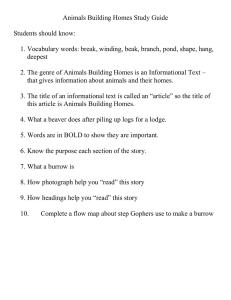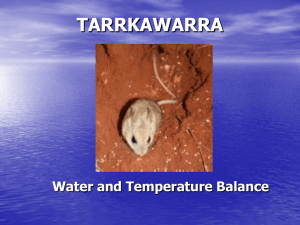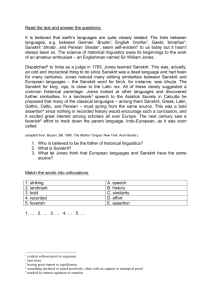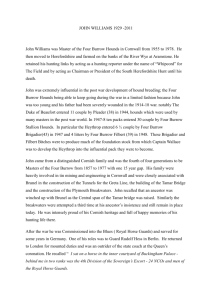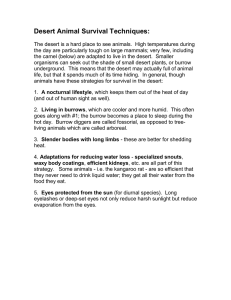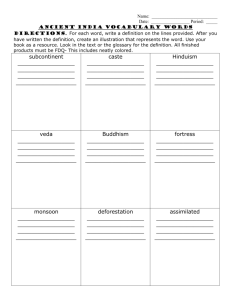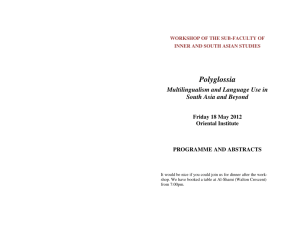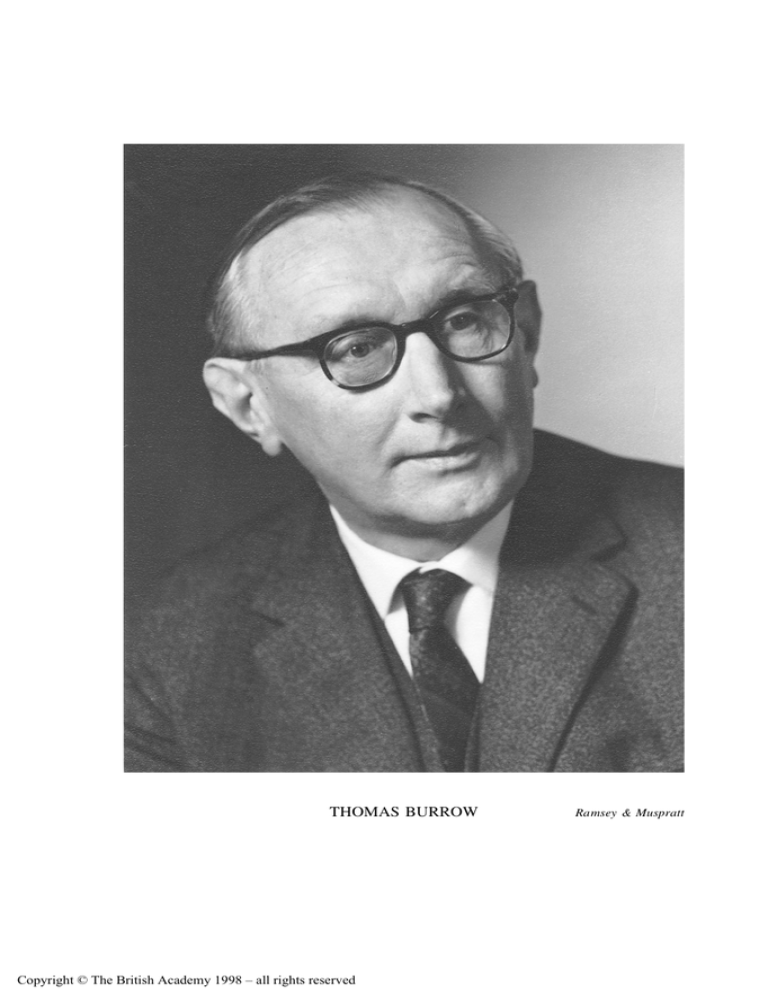
THOMAS BURROW
Copyright © The British Academy 1998 – all rights reserved
Ramsey & Muspratt
Thomas Burrow
1909–1986
THOMAS BURROW, Boden Professor of Sanskrit in the University of Oxford
1944–76, uniquely made an original and in many respects decisive contribution to both Indo-Aryan and Dravidian philology.1 As research student and
fellow at Christ’s College, Cambridge, in the 1930s, he described, from
recently deciphered administrative documents in Kharoshti script, the version
of the Gandhari Prakrit language that was in use in Chinese Turkestan c. AD
300. His translation of the documents followed in 1940. While employed in the
Department of Oriental Printed Books and Manuscripts, British Museum,
1937–44, he began to establish a systematic comparative historical philology
of the Dravidian languages which, coupled with his equally pioneering
descriptions of individual tribal languages, led to the magnificent Dravidian
etymological dictionary (with M. B. Emeneau; 1961, rev. edn. 1984). At
Oxford, he began a series of Sanskrit lexical, grammatical, and phonological
studies which culminated in The Sanskrit language (in the series The Great
Languages; 1955, rev. edn. 1973) and The problem of shwa in Sanskrit (1979)
and on which, despite failing eyesight, he was actively engaged until his
sudden death in 1986 aged 76.
Born on 29 June 1909, he was educated at Queen Elizabeth Grammar
School, Kirkby Lonsdale, and Christ’s College, Cambridge, where he read
for the Classical Tripos until specialisation in Comparative Philology led him
to study Indology under the tuition of E. J. Rapson, principal co-editor of the
administrative documents from the kingdom of Shan-shan in Chinese
1
I gratefully acknowledge bibliographical and biographical assistance from E. Tucker and
G. R. Hart of Oxford. T. H. Barrett (SOAS) and R. Salomon (University of Washington,
Seattle) kindly provided bibliographical data with reference to Niya Prakrit.
The British Academy 1998.
Proceedings of the British Academy, 97, 235–254
q
Copyright © The British Academy 1998 – all rights reserved
236
J. C. Wright
Turkestan.2 He was awarded First Class Honours in both parts of the Oriental
Languages Tripos and studied for a year in London at the School of Oriental
[and African] Studies, working on the Kharoshti script and Prakrit language of
those documents and benefiting there from H. W. Bailey’s expertise in dealing
with the Iranian and other extraneous elements involved.
The results of this work appeared in articles from 1934, followed by The
language of the Kharos. .t hi documents from Chinese Turkestan (CUP, 1937),
for which he had been awarded the Ph.D. degree of the University of
Cambridge, and eventually by A translation of the Kharos. .t hi documents
from Chinese Turkestan, published by the Royal Asiatic Society (London,
1940, in the Forlong Fund series). Unique as is the survival of an ancient
Indo-Aryan administrative archive, the purely Sinological relevance of its
actual content has inhibited any serious attempt, from the Indological side,
to improve upon these as yet provisional treatments of form and content. John
Brough’s description of the kingdom3 has, however, confirmed Burrow’s
readings and interpretation of some key passages. A Chinese rendering has
been published on the basis of Burrow’s translation; and his work has provided
some 800 lexical attestations of the language for R. L. Turner’s Comparative
dictionary of the Indo-Aryan languages (London, 1966).
The morphology and syntax of these Prakrit documents were shown to
have reached a stage of development that is scarcely attested in the other IndoAryan languages within India before the second millennium AD. Developments
such as the loss of distinction between nominative and accusative, and the
formation of a new synthetic preterite tense, could not have been suspected on
the basis of literary texts in Gandhari Prakrit, which substantially retain the
syntax of the sub-continent.
Oskar von Hinüber did not consider it appropriate to include the grammar
of the dialect in his survey of recent research on the early Middle Indo-Aryan
languages.4 It may be, however, that in spite of von Hinüber’s view of the
changes as ‘Sonderentwicklungen, die durch Einflüsse aus zentralasiatischen
Sprachen wie Sakisch oder Tocharisch erklärt werden können’ (Das ältere
Mittelindisch im Überblick, 67), Burrow’s belief (The language of the Khar.
docs., vi) that ‘There is no reason to impute this to the users of the language in
2
Kharos..t hß inscriptions . . . discovered at the Niya, Endere, and Lou-lan sites 1906–7
(Oxford, 1920–9).
3
‘Comments on third-century Shan-shan and the history of Buddhism’, BSOAS, 28, 3
(1965), 582 ff. = Coll. papers (London, 1996), 276 ff. Burrow’s materials were also used
by the Japanese and Chinese historians Nagasawa Kazutoshi, Enoki Kazuo, Ma Yong, and
Lin Meicun for their comments on the history of the kingdom, and by the last-named for his
Chinese version of the documents and for his study of ‘A new Kharos..t hı- wooden tablet from
China’, BSOAS, 53, 2, (1990), 283 ff. (For references, see Brough, BSOAS, 33, 1 (1970), 39
= Coll. papers, 297, 351, and Lin, op. cit., 290 n.)
4
Das ältere Mittelindisch im Überblick (Wien, 1986).
Copyright © The British Academy 1998 – all rights reserved
THOMAS BURROW
237
Central Asia, because with them it was a stereotyped official language,
whereas the phenomena observed are those of normal linguistic change’
represents the truth of the matter. The particularly striking formation of an
active preterite from the passive participle is paralleled in Khotanese Saka, and
there is at least partial collision of the direct cases in Tocharian. Since,
however, both phenomena recur in the modern Dardic of the north-west,
perhaps the decisive factor was an exposure to Iranian influence in Gandhara.
This was the case with regard to lexical borrowing, as has recently been
confirmed by Dieter Weber in Languages and scripts of Central Asia, ed. by
Akiner and Sims-Williams (London, 1997), p. 31.
From 1938, Burrow was able to devote much of his time to Tamil and the
other major Dravidian languages. Excused military service on grounds of
impaired vision, and given custody of the South Asian books that had been
evacuated from the British Museum, he proceeded avidly to study both texts
and lexica. As noted by Emeneau, who worked with him at Oxford in 1956–7,
one of his great assets was a prodigious and tenacious memory.
Like Turner in the field of the modern Indo-Aryan languages in 1914,
Burrow had encountered a language family that had yet to be subjected to
Neo-grammarian scrutiny, and where comparison with Tamil forms had
consistently passed for historical linguistics. His ‘Dravidian studies’ (BSOAS,
1937–48 = Collected papers on Dravidian linguistics, Annamalainagar,
1968) examined the most basic sets of vocalic and consonantal correspondences in order to establish the actual direction and relative chronology of
change.5
Building on the pioneer work of Gundert and Kittel, he also tackled the
problem of identifying Dravidian loanwords in Sanskrit, a problem bedevilled
by the pan-Indian tendency to adopt Sanskritised forms in lieu of or alongside
inherited vocabulary, and by the impossibility of identifying with certainty the
ultimate source of the bulk of the shared vocabulary. Some 500 lexical items
were examined, together with considerations of methodology, in articles from
1945 onwards, and eventually incorporated in the Burrow–Emeneau Dravidian
etymological dictionary (DED) (Oxford, 1961), and its Supplement (Oxford,
1968). There were some additions in 1970 and 1983, and numerous retractions
in the revised edition (DEDR (Oxford, 1984), Appendix). The material has
been used and evaluated in M. Mayrhofer, Kurzgefasstes etymologisches
5
Bhadriraju Krishnamurti, ‘Comparative Dravidian studies’, in Current trends in linguistics, 5 (1969), 309 ff. includes a detailed account of Burrow’s contribution: ‘his lucid and
definitive statements . . . constitute the beginning of a true comparative phonology for
Dravidian’. He reviews Burrow’s contribution to the question of Dravidian–Uralian affinity
(‘Drav. studies IV’). Otto Schrader had culled a common stock of 70 basic words connected
with human physiology (30% of all such vocabulary in the Kannada dictionary): Burrow,
from first-hand knowledge, found 72 words, retaining only 17 of Schrader’s equations.
Copyright © The British Academy 1998 – all rights reserved
238
J. C. Wright
Wörterbuch des Altindischen (KEWA) (Heidelberg, 1956–76) and Etymologisches Wörterbuch des Altindoarischen (EWA) (Heidelberg, 1986–).6
The retractions (in cases where the word was later deemed to be of IndoAryan or other extraneous origin) draw attention to the large measure of
uncertainty that still remains, in the absence of any large-scale investigation
of the shared vocabulary. One of them, Tamil pacantu (DEDR 4054 and App.
46) was evidently unmasked only at the last moment as the common Urdu
word pasand. It was decided, for example, that Tamil cūt. akam, Gondi sūr. a
‘bracelet’ (App. 39) must stem from Prakrit cūla(a), and not vice versa: but
such questions might better have been left open. The original Prakrit, rather
than Sanskrit provenance of Indo-Aryan loans in Dravidian was long overlooked, so that Telugu mēna and Tamil maittun-an-, maccin-an- (designating a
relation by marriage) had not been recognised as stages in the Sanskritisation,
as well as in the assimilation, of a loan from Prakrit mehun. a (< maithuna).
Indeed the presentation in 1984 (DEDR, App. 53) still appears to misread the
situation, by giving precedence to the mock-Sanskrit form maittun-a-, although
this is not known ever to have taken on the meaning that developed in Prakrit.
In 1949, M. B. Emeneau of the University of California at Berkeley,
following his own extensive fieldwork on four non-literary Dravidian
languages (Kota, Toda, Kod. agu, Kolami) had made the proposal that Burrow
should collaborate with him on an etymological dictionary, which would
facilitate research on Dravidian comparative linguistics by making available
to other scholars Burrow’s collections of material from literary sources, as well
as Emeneau’s unpublished vocabularies. Seeing, however, that the finer details
of phonology, and eventually the rudiments of morphology, would only be
worked out when all the available evidence was collected, Burrow also turned
to fieldwork. Of this aspect of Burrow’s work Emeneau wrote:
In another phase of his Dravidian scholarship he was a pioneer. Up to 1940 the
tribal languages of India had been investigated in the main by civil servants
and missionaries, with the exception of my own professional work in the 30s
on several languages that were easily accessible to investigation. Beginning
in 1950, Burrow used a new operational method. He teamed up with the late
Sri Sudhibhushan Bhattacharya of the Anthropological Survey of India . . .,
whose collaboration was indispensable on all levels, but especially as interpreter. In a succession of fieldtrips in the 50s and 60s in Central India, in
country usually very inaccessible, they investigated a number of Dravidian
tribal languages that had been previously only badly known or not even
known at all. This resulted in joint publication of two books and numerous
articles. This type of joint research has since then been normal. . . .7
6
Cf. also notably Mayrhofer’s reviews of DED in Kratylos, 6 (1961), 154 ff. and DED(S) in
13 (1968 [1969]), 208 ff.
7
IL, 47 (1986), unpag.
Copyright © The British Academy 1998 – all rights reserved
THOMAS BURROW
239
For The Parji language (1953) and The Pengo language (1970), Burrow
and Bhattacharya had recorded virtually unknown dialects from the hinterland of the Eastern Ghats, offering basic and interim grammar, vocabulary,
and sets of texts, adequate for the immediate purpose of lexical comparison
and for establishing the connection of Pengo with the Gondi group and the
independent status of Parji within the Kolami–Gadba group. These and other
publications and their fieldnotes cover Kon. d. a, Kui, Kuwi (of the Gondi
group) to the north, Man. d. a (allied to Pengo), Gadba to the east, and Kolami
to the west.
The Burrow–Emeneau etymological dictionaries amply achieved their
objective, so that in Dravidology ‘there has hardly been an article or publication since 1961 which has not liberally drawn on the materials collected
and organized in this work’ (Bh. Krishnamurti). They are rather of the genre
of comparative dictionaries, since the aim was to make Dravidian etymology
possible by scrutinising and (so far as possible) verifying all the available
lexical material and grouping like with like: there are over 5,500 lemmata,
supported by data drawn from up to twenty-eight Dravidian languages and by
the attestation of loans into ancient and modern Indo-Aryan. The crossreferencing (also to the Comparative dictionary of the Indo-Aryan languages)
and indexing, including a compressed but highly useful index of English
meanings, are all that one could wish for, and misprints are virtually
unknown. Since the individual languages have sorely lacked dictionaries
on historical principles, DEDR is an important tool for literary as well as
linguistic research.
Meanwhile, Burrow was making a large and potentially equally important
contribution to the historical phonology, morphology, and semantics of
Sanskrit. The originality of his approach made his work both stimulating
and often controversial: rightly so, for Sanskrit grammars and lexica had
remained static for half a century, often reflecting an uneasy interim compromise between Indian traditional opinion and European philology. Two
newly discovered languages, Hittite and Tocharian, had shown little sign of
supporting the view of the Indo-European parent language that had been
reconstructed in their absence, from the languages—such as Sanskrit—that
had achieved the most sophisticated level of grammatical refinement. He
introduced this new evidence, together with the ‘laryngeal’ theory, to a very
large Anglophone audience, via the Philological Society (‘‘‘Shwa’’ in Sanskrit’, TPS, 1949) and his book The Sanskrit language in Faber and Faber’s
widely read series The Great Languages (London, 1955, 1959, 1965, rev.
edn. 1973).
In so doing he was one of the first Sanskritists to accept that there is IndoAryan support for the postulation of a ‘consonantal shwa’ (or ‘laryngeal’ h-) in
the parent language, to whose influence had been ascribed inter alia the
Copyright © The British Academy 1998 – all rights reserved
240
J. C. Wright
existence of radical long vowels and the voiceless (and some of the voiced)
aspirate consonants, points which, though hardly proven or provable, remain
standard doctrine.8 He refused to accept the postulation of a ‘vocalic shwa’, and
this view, unusual at the time, has since been firmly endorsed by Mayrhofer in
1981 and 1986.9 It led him, however, with perfect consistency, to deny the
strict identity of, for example, Sanskrit pitŕ. and Greek πατη* ρ as manifesting
such a vowel in the root syllable.
Virtually no scholar was then prepared to support this assault on one of the
longest standing axioms of Indo-European Comparative Philology. Though
Burrow repeated the thesis in The Sanskrit language, his prediction10 that ‘the
rewriting of all our handbooks of IE comparative grammar . . . as far as @ is
concerned is unavoidable, and this creation has become so pervasive in the
theory of Indo-European that its removal entails the rewriting of a good deal
besides’ has quite failed to materialise. Kuryłowicz’s systematic and
equally innovative L’apophonie en indo-européen (Wrocław, 1956) retained
shwa, as did his Problèmes de linguistique indo-européenne (Wrocław, 1977).
Szemerényi’s influential Einführung in die vergleichende Sprachwissenschaft
(Darmstadt, 1970, rev. edn. 1990) still states that ‘Schwa . . . ergibt sich aus
morphologisch ganz klaren Entsprechungen wie skt. . . . pitar- . . . a-di-ta’
and gives no credence to G.Av. ptā and Skt -tta, or indeed to Burrow and his
move to treat the -i-/-a- of pitŕ. /πατη* ρ as a secondary phenomenon as compared with the -a-/-a- of pairs such as ślaks. n. á/λαγν¾v.
Yet the consensus view, as now described by Mayrhofer, is not entirely
convincing. Mayrhofer conceded only grudgingly that the proliferation of
vocalic reflexes in Indo-Iranian is dialectal,11 and, while denying the
possibility of a single basic ‘Murmelvokal’ (Idg. Gr., 1986, 122 and
177), has adopted instead three individual and unstable vocalic entities,
variously labelled ‘vokalische Kontinuanten’ (p. 126), ‘überkurzer Sprossvokal’ (p. 138), and ‘Fortsetzung’ (p. 142) which all collided in Indo8
M. Mayrhofer, Indogermanische Grammatik (Idg. Gr.), I, 2 (Heidelberg, 1986), 121 ff.
Indogermanische Grammatik 122 f., 177 ‘jener ‘‘Murmelvokal’’, der auf nicht ganz
aufgeklärte Weise im ausgehenden 19. Jahrhundert an die Stelle der sonantischen
Koeffizienten Ferdinand de Saussures gesetzt worden ist’. Cf. idem, ‘Laryngalreflexe im
Indo-Iranischen’, ZPSC, 34 (1981), 429 = Ausg. kl. Schr., II, 294.
10
1949, 61.
11
His ‘Laryngalreflexe’, 436 mentions ‘das . . . vielleicht auch durch Dialektunterschiede
gestörte Material’; much reliance is placed on Pkt āgamamßn. a, Y.Av. pita (and O.Pers. pitā),
despite older G.Av. -@mna and (p)tā (versus f@ðrōi/piθrē, to which may be added za˛ qā in Y
44.3 za˛θā pa+ tā = pitā* janitā* , different from Y 43.5 za˛ qa, v.l. za˛θβa, ‘birth’; see EWA, s.v.
janitár). Mayrhofer does not mention Burrow’s understandable objection to the impression
that this creates of derivation of the monosyllable (p)tā from a monosyllable (*pHtā) via the
disyllable pitā. For Burrow, parallels for the otiose extension -i- seen in pi-tŕ. , sthi-tá, etc. are
provided e.g. by √sā-, si-, √śā-s, śi-s. -, and by Gk δολι-χ¾v alongside Skt dßr-gháh. , Hitt.
dalu-gaš.
9
Copyright © The British Academy 1998 – all rights reserved
THOMAS BURROW
241
Iranian with the vowel *i.12 Szemerényi, resisting both Burrow’s and
Mayrhofer’s revised versions of the hypothesis, eventually (reviewing
Burrow’s Problem of shwa in Sanskrit in Kratylos, 28, 1983, 75) admitted
the need for a comprehensive analysis of all instances where Skt -i- has hitherto
been regarded as derived from shwa. Burrow, he declared, ‘would obviously
bring the best possible qualifications for such a difficult task’, but the call came
too late. Similar was the reaction of Hiersche in OLZ, 1982, 6, 595 ff.
The most strenuous objection that had been voiced by earlier reviewers
concerned the precious identity of pitŕ. and πατη* ρ (Benveniste)13 and of
(pr.n.)ßmah. and (δα* µν)αµεv (Gonda):14 these critics too made no mention of
Av. ptā and ( friia˛n)mah· which, as far as Burrow was concerned, prove that
the identity is illusory. Martinet15 made explicit the critics’ assumption that
Burrow’s notation p-itā´, duh-itā´ (1949, 38 f.) implied an analysis π-ατη* r, θυγα* τηρ with an unacceptable suffix *-ater. Burrow later acknowledged the fault,
although his article in fact had gone on to explain the -i- as a root extension (p.
46: ‘the root extended by suffixal i’), and to describe (p. 59) Gk. sτ-α-τ¾v in
terms reminiscent of his view (p. 23) of Skt darś-a-táh. as a post-Ablaut
formation with multiple full-grade vowels (unlike the more primitive sthi-táh.
and dr. s. -t. áh. ). Burrow’s ill-considered attempt to explain the phenomenon in
terms of serial extensions, such as he envisaged in hár-i, harı́-t, hárit-a and
in √śā-s-, ś-i-s. - and √sā-dh-, s-i-dh-, also distressed the critics, though they
might have seen that the gaucherie of this argumentation scarcely affects the
main point at issue, i.e. that, whether they are to be explained on the basis of
epenthesis or proliferation of existing suffixes, there is no need for a
laryngeal explanation for the appearance of such medial vowels.
He might have strengthened the case for scepsis by questioning the
generally held belief that Indian grammatical theory has any bearing on
the matter. Like others, he referred to tr̄. - and san- as ‘so-called set. -roots’
(p. 26), thus fostering the impression that the grammarians had actually
envisaged ‘tari-’ and ‘sani-’ as alternative forms of the roots. Burrow’s
protest may have been tacitly influenced by the fact that Pān.ini speaks
(7.2.10, 35) only of suffixes as being regularly prefixed with i- (set. ), but
exceptionally also unprefixed (anit. ) in the case of so-called ‘anudātta’
12
Mayrhofer had previously tended rather to contemplate the sonorisation of fricatives:
Nach hundert Jahren (Heidelberg, 1981) (=SbHAW, 8, 1981), 18 f.
13
BSL, LI (1955), 25: ‘Je ne crois pas qu’aucun comparatiste sait (sic) tenté d’adopter cette
vue extrême’. Precisely the word pitŕ. was and is a bad choice as a support for shwa: it seems
likely that, as in the case of mātŕ. (EWA, s.v.), a childish word has been assigned grammatical
gender (pa-/mā-) and declension (after the manner of náp-t, náp-t-r. ?).
14
Lingua, VI (1957), 289.
15
Word, X (1956), 304 ff.
Copyright © The British Academy 1998 – all rights reserved
242
J. C. Wright
roots.16 The twelfth-century commentary on Dhātupāt.ha concurs, although
itself participating in the eventual confusion: pratyayasya set. tve ’nit. tve ca,
upacārād dhātos tathāvyapadeśah. ‘While it is the suffix that is set. or anit. ,
the terms may be loosely applied to the root’ (Ks.·rasvāmin S.V. bhū´).
Pān.ini’s sources, enshrined in the Dhātupāt.ha, were presumably concerned
to identify a ‘regular’ -a-/-i- conjugation of verbs, so that the list of roots
was subdivided first on the basis of strong and weak stems in the present
system (bháva-/ad-), then on the basis of the strength of stems elsewhere
(bhavis.yá-/dhaks.yá-), and finally on the basis of the strength of personal
endings (dvis..té/dvés..t i). Certainly, the result was that lists of strong verbs
(‘udātta’) with se. .t conjugation and of weak verbs (‘anudātta’) with anit.
conjugation) were prepared; but at no point was the -i- deemed to be integral
to the root. The later tendency to talk of ‘set. roots’ instead of ‘udātta roots’
will reflect the fact that the term udātta had become meaningless, once
Pān.ini had determined that -i- is integral, not to the conjugated tense stem,
but to the suffix.
Burrow reinforced his attack on the vocalic shwa in an article in Pratidānam, 1968, and in The problem of shwa in Sanskrit (Oxford, 1979). In the
latter, he compiled a more complete repertoire of instances of the reducedgrade vowel -a- in Sanskrit (rā-, rá-tna; vidā-, vidá-tha, and the like), which
would rule out the notion of vocalic shwa (-i-) as a reduced grade.17 He was by
16
The traditional, merely mnemonic application of the terms ‘udātta’ and ‘anudātta’,
‘anudāttet’ and ‘udāttet’ used in the Dhātupāt. ha, being consistently applicable only to
consonant-final roots, is surely secondary. The terms udātta ‘accented’ and anudātta
‘unaccented’ have no bearing on the accentuation of the set. /anit. forms themselves, but
seem intended to associate ‘regular’ set. future stems like bhavis. yá- with such ‘regular’
root-accented present stems as bháva-; and to associate ‘irregular’ non-presents like (Sū.)
sos. ya- and (Gr.) totsya- with such ‘irregular’ root-unaccented presents as sunóti, tudáti.
Thus bháva-, bhavis. yá- is ‘udātta par excellence’ and sunó-, sos. ya- is ‘anudātta par
excellence’. In the root-accented Classes I and IV, udātta verbs constitute respectively
some 90% and 60% of the class and take precedence as the norm; but in classes such as V
and VI, anudātta verbs, which yield only some 50% and 25% of the respective totals, are
given precedence. (Sub-groups, vowel-ending or grammatically motivated, are another
matter, being arranged according to notions of cyclic digression, the only principle of
sequence that Palsule was able to detect: see The Sanskrit Dhātupāt. has, Poona, 1961, 31;
udātta verbs take precedence in Class VIII, in keeping with the ostensible strength of the
root syllable.)
This classification, involving an extension of the concept of accentual strength, and
reflecting a rather post-Vedic notion of regular -a-/-i- conjugation, presumably inspired the
more sophisticated sub-classification of roots into udāttet, etc., where the terms correlate
strength of stems with voice. The ‘anudāttet’ weak stems, associated with strong middlevoice endings, take precedence in the more basic consonant-final bhūvādi categories over
‘udāttet’ strong stems with weak active endings (cf. -nuté/-nóti respectively); and ‘svaritet’
serves to denote a combination of strong and weak stems.
17
‘never before has the complete material been put together in such an impressive fashion’:
O. Szemerényi, Kratylos, 28 (1983), 73 f.
Copyright © The British Academy 1998 – all rights reserved
THOMAS BURROW
243
now willing to accept laryngeals only where directly attested in Hittite. He
stressed the failure of Hittite to support the theory of laryngeal-induced
lengthening: Hitt. pahš- ‘protect’ is virtually unique; Skt dāntá and damayati
would seem to owe their vocalism to their disyllabic base (cf. Hitt. damaš-);
and (in the absence of corresponding disyllabic bases) there is no evidence that
*terH and *senH (Hitt. tarh- and šanh-) could yield anything but a *tārayati
(unattested in the relevant sense ‘overcome’) and sānayati (presupposed by a
Vārttika). Burrow did, however, adopt the notion of a glottal fricative as a
pointer to the mechanism that would serve both to lengthen Skt -sūta, suvāná
over against -suta, -svāná and (provided one upheld Brugmann’s Law) to
preserve the short radical syllable in janayati as against kārayati. The
suggestion has at least the merit of offering a convenient notation jan’ for
nasal long-sonant roots in Sanskrit, preferable to the shwa-based notation JAN I
that has been adopted by Mayrhofer.
This length-generating and length-retarding factor, conceived (in deference to Saussure’s theory of disyllabic bases) as the ‘residual trace’ of a
vowel, was a laryngeal in all but name, and it appealed to no-one as an
improvement upon the shwa hypothesis or the laryngeal hypothesis. In respect
of the pure vowels, he had abandoned the proposition that a lengthening
process must inevitably involve some pre-existing vocalic or consonantal
trigger; but he drew no moral from this, nor did he observe that the Sanskrit
grammarians’ postulation of long-sonant roots on the one hand and of set.
suffixes on the other is an inadequate guide to the Avestan and R.gvedic
material as a whole.
Burrow did not realise the extent to which the assumption of medial
consonantal shwas, which he had accepted, is bound up with, or even dependent on, the postulation of vocalic shwa. Saussure believed that ‘sonant
coefficients’ *A and *O (i.e. the eventually postulated laryngeal consonants)
were necessary to explain vowel length in one particular category of root
syllables; and that they yielded in isolation a single weak vowel (eventually
labelled shwa and styled an allophone of zero). This belief presupposed the
surprising assumption that in Indo-Iranian his coefficients *A and *O could
collide with *i; it also assumed a link between the fictitious long-sonant roots
(kr̄. -, pr̄. -, etc.) and the proliferating morpheme divider -i-, both features more
obviously typical of Sanskrit than of the proto-Indo-Iranian one might have
inferred from Av. dar@ga, dug@dar, and (p)tā.18
To carry conviction it would have been necessary to widen the campaign.
The general anxiety to uphold the equation στατ¾v /sthitá reflected the feeling
that it importantly substantiates the putative laryngeal explanation of the
18
For the dependence of Saussure’s proto-laryngeal on his proto-shwa, cf. Mayrhofer, Nach
hundert Jahren, 23, n. 67, and 28, n. 79.
Copyright © The British Academy 1998 – all rights reserved
244
J. C. Wright
vocalism and of the aspiration of sthā-. Burrow did go so far as to deny (1979,
20) that an isolated equation like Skt pā-s-/Hitt. pah-š- has any bearing on the
vocalism of Skt sthā-; but he might have strengthened his position by observing that there is no need to assume that the aspiration of sthā- reflects
anything more than a purely Indo-Iranian tendency to avoid the ambiguity
of unaspirated forms like abhis..ti (‘aid’ = ‘Bei-stand’: EWA).19 In another
instance where a significant laryngealist tenet rested on one dubious example,
Burrow’s scepticism was apparent, but unproductive: ‘It is believed that one
type of IE H . . . affected a preceding surd differently, by voicing it, in Sanskrit
pı́bati = O. Ir. ibid ‘‘drinks’’ . . . but this appears to be the only example’
(1955, 71 f.; cf. 1979, 37).20 With his commitment to Dravidian linguistics and
to completing the revision of DED, however, he was in no position to mount
the implied full-scale reappraisal required.21
He did not survive to take stock of the evidence which in 1986 Mayrhofer
marshalled as irrefutable proof of the ubiquity of laryngeals. If Burrow was
right, the main surviving relevance of laryngeals would be to the occasionally
disyllabic -ā- of Indo-Iranian and other syllable-initial phenomena with which
neither Saussure nor he was concerned, e.g. bhā´s = bhá’as (RV 6.10.4), pā´nt =
pa’ant (9.65.28–30), and vā´ta ‘wind’ = vá’ata (9.97.52, etc.: EWA *vaHata-,
Hitt./huu7ant-/).22 Burrow’s only relevant comment (1955, 238, on the disyllabic suffix in tés.ām) does not address the main problem: but since Hittite offers
no medial laryngeal in its version of vā´ta, he would have been undismayed.
His willingness in 1955 to accept the consonantal aspects of recent
laryngeal theory (deriving Skt tß r-n. á, tirati from *tirH- and ráth(i)ya from
*rotHiHo, and so forth), while denying the long-standing vocalic shwa, gave a
doubly innovative aspect to his most widely read work The Sanskrit language.
Appearing at a time when it was Comparative Philology more than anything
else that drew students to Sanskrit, the book combined a detailed comparative
historical phonology and morphology (primarily of Vedic) with a masterfully
compact survey of its Indo-European prehistory and its subsequent debt to
19
Mayrhofer, Sanskrit und die Sprachen Alteuropas (Göttingen, 1983), 433, considered a
laryngeal the only possible explanation for Skt path-: but Av. pad@bßš (‘paths’) reveals that
there had been a need in Sanskrit to create a distinction between pathı́bhih. (‘paths’) and
pad. bhı́h. (‘feet’).
20
Despite Mayrhofer (Idg. Gr., I, 2, 143, n. 184), the possibility that an onomatopoeic *bib(Latin bibit) has been influenced by *pō-, seems worth canvassing. (Unlike Pokorny, IEW,
1969, Mayrhofer cites O.Irish ibid as 2 pl. imperative.)
21
‘Burrow gehört zweifellos zu jener Art von Forschern, die kühn Schneisen schlagen und
anderen das Aufräumen überlassen’: R. Hiersche, OLZ, 1982, 6, 597.
22
For vā´ta, see notably ‘Die Vertretung der idg. Laryngale im Lateinischen’, KZ, 100, 1987,
97 n. = Ausg. kl. Schr., II, 421 n.); for pā´nt m. ‘drink’ (the stem pā´nta is required only for the
neuter transposition pā´nta, still with disyllable, at 10.88.1 hávis. pā´ntam . . . ā´hutam), see
EWA, S.V. PĀ2.
Copyright © The British Academy 1998 – all rights reserved
THOMAS BURROW
245
Middle Indo-Aryan, Dravidian, and Munda. It was thus the first general
treatment of Sanskrit that sought to exploit the Hittite evidence and the
laryngeal theory, while offering new insights into the post-Vedic evolution
of Sanskrit: but the format left him no room for manoeuvre in the matter of
referencing, indexing, and cross-referencing. Martinet, in his sympathetic
review, understood that Burrow had no choice but to make the book a
repository for his theory of apophony (no-one having offered any attempt at
refutation in the intervening seven years). He admired too ‘by far the most
lucid total presentation of laryngeal lore ever printed’ and the ‘amazingly
simplified picture of IE nominal derivation’: ‘with all its one-sidedness,
Burrow’s huge black and white fresco may convey a more valid impression
of what the nominal system of Indo-European may have been at a certain stage
than more painstaking and roundabout expositions’.
Burrow’s traditionalist view of Indo-European as a ‘two-dimensional’ (Martinet) amalgam of reconstructions was unpalatable to general linguists. Such
reviewers found fault with both his conservatism and his originality, and certainly he had committed himself to a fair number of ill-considered or even
inscrutable etymologies (e.g. náks. -atra and sy-oná respectively). Although
now sadly out of print, the years, its reprintings, the Hindi translation of 1965,
and constant citation in Anglophone circles have shown that it is a book that
continues to meet a need for the general reader and for the budding specialist.
Even the revised and improved edition of 1973 could do little to update all
of Burrow’s many knot-cutting solutions, only occasionally idiosyncratic or
ill-advised; and no-one has taken up the challenge to try and do better. It was
suggested by one reviewer of the revised edition23 that Burrow had simply
ignored justified criticism of the original, but this is by no means the case. The
problem was rather the pressure imposed upon him by his medium, which
evoked from Edgerton (JAOS, 1956, 193) the comment: ‘It is clear that he
knows the literature well, and in some cases a negative attitude can be detected
towards certain views which he does not think it necessary even to mention
specifically. It often takes a rather well-read specialist to divine what he is
doing in such silent polemics’.
Burrow’s reaction to Edgerton’s own comments is typical: in the case of
simple oversights (and the occasional howler: Russian zemlja had been credited with an -l- suffix), amendments were duly made. One detects, however, no
reaction to Edgerton’s complaint that the exposition of one original hypothesis,
postulating identity of the neuter ending -am with an athematic nominal
23
R. Schmitt, Kratylos, 17 (1972 [1974]), 203. M. Leumann had objected in Kratylos, 1
(1956), 29 to Burrow’s treatment of ks. /kt, etc.: in the one specific instance where Burrow
had indeed erred, the correction was made. The *teks-tōn that was also criticised was a veiled
allusion to proposals of Kuiper and Szemerényi; an improved formulation was only later
provided by Mayrhofer (see Idg. Gr, I, 2, 156).
Copyright © The British Academy 1998 – all rights reserved
246
J. C. Wright
derivative suffix -m, is seriously flawed. To justify this postulate, Burrow had
invoked yugmá ‘paired’ (BRD yugmá ‘paarig, geradezahlig’): but this is
actually a late Vedic form yugma whose predominant implication is ‘evennumbered’. As Edgerton observed, it seems to be a replacement for earlier
yugmán (ŚBr. yugmábhih. , R yugmāni); and even this version seems to replace
yug-mánt, antonym of á-yuj in TS. It is a serious criticism, but it by no means
invalidates the argument, since it seems as easy to deduce the desired suffix
-m- from -m-an, -m-ant as from thematic -m-a. A stimulating suggestion had
been made, where none existed before; and even a complete rewriting of the
three pages involved would have done nothing to satisfy those who would
demand an entirely more sophisticated treatment of the origins of case and
gender (noting that he had naively treated the masculine accusative -am as a
quite unrelated pre-existing entity), or those for whom such unverifiable
hypotheses have no place in such a book unless, like vocalic and consonantal
shwa, they have been around for a lengthy period. On the other hand, it would
not have been impossible to include in the new bibliographical note some
laconic reference to other specific factual criticisms.24
Burrow’s contribution to Indo-European reconstruction continued throughout his career, notably in his studies of anomalous sigmatic forms in Sanskrit
(‘The Sanskrit precative’, Asiatica, 1954 and ‘An archaic verbal termination in
early Indo-Aryan’, IIJ, 1957); the antecedents of the Sanskrit consonant group
ks. (‘On the phonological history of Sanskrit ks.am- ‘‘earth’’, ŕ.ks.a- ‘‘bear’’ and
liks.a- ‘‘nit’’ ’ and ‘Sanskrit ks.i-: Greek fq¬nw’, JAOS, 1959); the development
of retroflex consonants in Sanskrit (‘Spontaneous cerebrals in Sanskrit’ and ‘A
reconsideration of Fortunatov’s law’, BSOAS, 1971–2); and vowel-length
based on original -o- (‘A new look at Brugmann’s law’, BSOAS, 1975).
His rejection of vocalic shwa apparently owed much25 to Meillet’s observation in BSL, 1933, that a proliferation of sigmatic forms (where preterite
endings with initial t- are involved) is common to the Sanskrit -is. - aorist and to
the -is- preterites of Latin and Hittite. It was the preconception of vocalic shwa
that had prevented Meillet from postulating a common Indo-European source
for the -is- forms of Sanskrit (a mainstay of shwa theory), and those of Latin,
Armenian, and Hittite. By identifying an Avestan correlate tuyāº for the Vedic
3 sg. precative active bhūyā´h. , and by collecting instances of anomalous 3 sg.
-stha, Burrow was able to link these with 3 sg. -s and -sta preterite endings
24
Such a list would have remained eclectic: Burrow was under no obligation to endorse all
of Thieme’s hostile criticisms (Language, 1955, 428 ff. = JBRS, 58, 1972, 197 ff.), the more
general of which are based on some fundamental misunderstanding of Burrow’s formulations, always Pān.ini-wise brief and careful. One must, however, regret Burrow’s failure to
accept that a syoná ‘soft, agreeable’ is unacceptable as evidence of a suffix -avana, -ona; and
that an arı́ ‘devoted, trustworthy, pious’, apparently from Sāyan.a’s ‘yajamāna’ via BRD
‘anhänglich’ and MW ‘faithful’, is unduly eccentric (cf. Thieme, 1955, 433).
25
Cf. Burrow, TPS (1949), 56 ‘certain formations in -i-’ (a characteristically tacit reference); Asiatica (1954), 39; IIJ (1957), 74 f.
Copyright © The British Academy 1998 – all rights reserved
THOMAS BURROW
247
found in Hittite, and hence to show that not just the Sanskrit precative but
the sigmatic aorist as a whole could be traced to an ending -s in the 3 sg. This is the
acknowledged basis of Watkins’s theory26 that all 3 sg. endings developed from
root extension, -t, -i, -s, -u. Like Burrow, Watkins has reduced the scope of vocalic
shwa by several categories: the Hittite -āi- diphthongs and the Indo-Iranian middle
endings *-i and *-madhi. Hence Watkins’s retention of it elsewhere, thus separating the Sanskrit -is. - aorist from the other sigmatic preterites and the Sanskrit suffix
-(i)man from Celtic *-(i)amon,27 can seem anomalous on occasion.
A significant contribution to the clarification of Indo-European phonology
was made by Burrow’s completion of Kretschmer and Brandenstein’s use of
Hittite and Tocharian evidence to solve the problems associated with certain
Greek cognates (κτ χθ φθ ) of Sanskrit ks. . He brought several key Indo-Iranian
forms (ŕ.ks.a, ks.iyánti, ks.ám, ks.ātı́, ks.in.ánti) into line with the rest of the
evidence by indicating that the Sanskrit reflex can derive not from ks but
from tś and d.z.h, and by suggesting a possible etymology (dah- ‘burn’ for
ks.ā- ‘burn’). The phonological developments involved have since been clarified by Kuiper and Mayrhofer, who has acknowledged in particular Burrow’s
contribution (JAOS, 1959) to Hittite-based solutions for ks.ám and ŕ.ks.a, while
disposing of certain doubts that had been expressed by Kuiper.28
H. W. Bailey having demonstrated that many Sanskrit words with retroflex
consonants have Iranian cognates with dentals, Burrow provided sufficient
additional material to imply that for etymological purposes retroflexion can
generally be ignored in the post-Vedic period. Following Mayrhofer, but deeming the whole process to be prehistoric, he inferred ‘a process of fission’ due to
‘spontaneous cerebralization’, although at least in the case of -n. - and -s. - it would
seem wiser to suggest dialect mixture (i.e. adoption of regional mān.ava and
abhilās.a to support semantic nuances distinct from mānava and vilāsa, ullāsa).29
His subsequent ‘reconsideration’ of that ‘permanent issue of dispute’,
Fortunatov’s Law, claimed ‘to establish it beyond all reasonable doubt’. It
revised the list of words to which the law might apply, i.e. those in which
retroflexion could possibly be due to -l- rather than -r-. The article encouraged
Cf. Watkins, Idg. Gr., III (1969), 53 ff. Burrow’s point (apās → ápāt) seems to be
overlooked by Oettinger, Stammbildung des hethitischen Verbums (1979), 435 and Mayrhofer, Idg. Gr., I, 2, 143 (‘a-pā-t → ápās’).
27
Idg. Gr. 54.
28
See Kuiper, IIJ, 10 (1967), 103 ff. and Mayrhofer, AÖAW, 119 (1982), 246 f. = Ausg. kl.
Schr., II, 261 f.; Idg. Gr., I, 2, 153 f.
29
The early R.gvedic instances (Mayrhofer, Mélanges d’indianisme, 1968, 509 ff.) seem to
correlate strongly with cultural objects and commodities: man.ı́ ‘(amulet) jewel’, sthū´n.ā
‘(monumental) pillar’, etc., so that it is not only vßn. ā ‘lute’ (p. 511) that may be branded a
borrowable ‘Kulturwort’. The dialect involved at this period might be that of Iranian artisans
or merchants, whose dentals would differ from Indo-Aryan post-dentals. The word pān.ı́, rare
as a simplex and denoting ‘hoof’ at 2.31.2, is arguably applied as a humorous vulgarism to
Indra’s hands at 4.21.9 (‘Don’t just sit there . . . ’). If so, the vulgar implication was soon lost.
26
Copyright © The British Academy 1998 – all rights reserved
248
J. C. Wright
Collinge to deliver his verdict that the ‘law’ still ranks as a ‘doubtful, but not
incredible’ proposition and ‘a useful label’.30 Its argument is, however, a
victim of Burrow’s surprisingly monolithic view of Prakrit. He felt obliged
to withdraw his very plausible explanation of abhilās.a (<abhilāsa lex.) on the
grounds that ‘in Prakrit all the sibilants have fallen together as s’ (BSOAS,
1972, 543 f.), as though only the standard literary medium would have any
influence on Sanskrit. Since this is not the case, and since graphic yas.o for yaso
may also play a part, the argument rebounds and there is no real incentive to
believe that RV pās.yā`, VS bhās. -, etc., are likely to owe their retroflexion to a
survival of -ls-. As all examples with -n. d. - had been withdrawn as inapplicable,
the case rests (p. 536 f.) on an alleged preponderance of instances of -t. -, -t. h-,
-d. h- from *-l-, as against -t/t. - and -tt/t. .t -, etc., from *-r-. Since, however, the
latter very clearly reflect semantic differentiation on the basis of dialect
mixture in Middle Indo-Aryan, and the former are generally reminiscent of
the categories of vocabulary for which he had sought to demonstrate early
‘spontaneous cerebralization’ (read ‘early dialect mixture’, with note 29,
above?), it is not surprising that the approach, on the evidence of subsequent
issues of Mayrhofer’s etymological dictionary, has failed to carry conviction.
One may regret Burrow’s rejection of plausible Dravidian etymologies, as for
tat.a and kun.i, under its incentive.31
In respect of Brugmann’s Law too, Burrow strove to reconcile nineteenthcentury theory with twentieth-century understanding of Sanskrit. The article in
BSOAS, 1975, which sought to establish a correlation between IE -o- vocalism
and the appearance of -ā- in Sanskrit in all types of syllable, has been
welcomed by Collinge32 as ‘a radical new treatment’ and ‘a courageous revival
and a notable clarification’: it encouraged him to believe that Sanskrit -ā- < IE
-o- might have a phonetic explanation (viz., inherently greater duration of the
back mid vowel). Mayrhofer quotes,33 without discussion, Burrow’s finding as
‘indoiran. /ā/ < idg. */o/ auch in geschlossener Silbe’. It must, however, be
30
The laws of Indo-European (Amsterdam/Philadelphia, 1985), 45.
RV jat. hára, with an implication of ‘tubby’ (ját. hala), seems semantically a good match
for pān.ı́ (above, n. 29). It is wrong to distance tat.a from Dravidian on the basis of a sense
‘slope’ (BRD, KEWA): appropriate is DEDR 3031 with tat. a- and the senses ‘impediment,
restraint (of water), embankment, dam’. Mbh. 1.32.3 himavatas tat. e refers to a Tı-rtha at the
back of beyond; R 4.12.16 nis.papāta . . . bhāskaro ’statat.ād iva refers to the bounds of the
Ocean, the ends of the earth, as do Megh. 60 prāleyādrer upatat. am and Kathās. 26.26
śabdapūritadiktat. ān: the respective translations ‘to the foot of’ (Ganguli), ‘over the top’
(Shastri), ‘near the skirt of’ (Kale), ‘filling the sides of heaven’ (Tawney), show BRD’s
alleged sense ‘slope’ to be inapplicable, as indeed do van Buitenen’s quaint ‘mortifications
on the slope of’ and Lefeber’s compromise ‘from behind the slope of’. The new Pléiade
transl. of Kathās. has, in the instance, rightly ‘limites de l’espace’. The error may reflect
misunderstanding of kat.ß-tat. a, etc., for which nothing implies ‘sloping’ (BRD ‘abhängig’):
rather ‘bounds, contour’ of hips, both slim (Mbh. 3.146.66) and ample (13.14.108).
32
The laws of Indo-European, 16 ff.
33
Idg. Gr., I, 2, 147.
31
Copyright © The British Academy 1998 – all rights reserved
THOMAS BURROW
249
emphasised that Burrow had to concede that the development is again not
uniform in all dialects. In fact, he made only a tacit assumption of Iranian
involvement, as when (p. 63) he passed over Av. ‘pāšna’ (Skt pā´rs.n.i)34
without comment, and (pp. 60, 63, 74, re *ou, *or, *oi) posited ‘a different
treatment of IE -o- in such positions as between Sanskrit and Avestan’, i.e. an
Iranian absence of Vr.ddhi that occurs also dialectally in Indo-Aryan (p. 70).
Burrow’s conviction (p. 75) of the inadequacy of attempts to link
Brugmann’s Law with a small handful of morphological categories is noteworthy. Mayrhofer (Idg. Gr., I, 2, 148) cites two such categories, without
prejudice, but also without stressing this aspect of Burrow’s thesis. Though it
is only to be expected that the distinctive weak grade that appears in hūtá would
encourage distinctive strong grades in āhavá, hávßman, and Pān. . hvāyayati, and
that cakara would be resistant to lengthening, in company with cakartha and
in contrast with cakāra, Mayrhofer is in such cases compelled by Brugmann’s
shwa, if not by Brugmann’s Law, to believe that post-consonantal laryngeals
must still have been active here in early Indo-Iranian. A Brugmann-inspired
desire to find a way of closing the radical syllable in cakara and janayati
compelled Burrow to retain the theoretical laryngeal and, shortly afterwards in
The problem of shwa in Sanskrit, to attempt a new explanation for the
phenomenon. In this context too, as Collinge has shown (The laws of IndoEuropean, 17), Burrow’s attempt at a compromise has weakened his important
demonstration of the wide scope of the phenomenon in Sanskrit, so that his
contribution to Brugmann’s Law has had no more evident impact than his
assault on Brugmann’s shwa.
In ‘The Proto-Indoaryans’ (JRAS, 1973), he gave a critical survey of research
on the early location and interaction of Iranians and Indo-Aryans, and this has
remained an oft-quoted source in subsequent discussions. He offered a useful
historical argument with which to counter the traditional late dating of the
Zoroastrian Gathas. He coupled this with a plausible theory that the Iranians
must have encountered the Indo-Aryans already established in the vicinity of
Eastern Iran, and he sought to support this with the more dubious contention35
34
Surely one may read Av. pāšni (pāšn<aē>ibiia in Vid. 8.70 f.; n8 <ā> ibiia in most MSS at
.
2.31) versus derived kasu-pāšna, zairi-pāšna: cf. notably RV -angula, Av. -aÎura.
35
The counter-argument of Boyce (History of Zoroastrianism, I, (Leiden, 1975), 55, with n.
211), that the Zoroastrian objection to Daēvas was spiritual and ethical (and not noticeably
xenophobic), did not go far enough. Gnoli relied on her argument so far as the term Daēva is
concerned; but Burrow’s philological argument (JRAS, 1973, 130 f.) in general lacks cogency.
The authenticity of Av. daēva ‘god’ is not threatened by the coexistence of baga, any more
than that of RV devá by bhága (which latter is in Vedic a divine epithet and not only, as
Burrow stated, ‘the name of a particular deity’); the suggestion that in all Avestan literature
‘there is no sign of any such classification as that into Devas and Asuras’ is hard to reconcile
with the existence of a detailed pandemonium in Vid. 10 and of references to a plurality of
Ahuras. The notion of a twofold wind, favourable and unfavourable, in Iranian corresponds to
two antithetical Vātas in RV 2.39.5 (left and right) and 10.137.2 (to and fro), so that it suggests
more a potential basis for fission into Yazata and Daēva than the merging of two ethnic rivals.
Copyright © The British Academy 1998 – all rights reserved
250
J. C. Wright
that the word Deva, together with many of the Deva names, Varun.a, Indra, etc.,
was an innovation peculiar to the Indo-Aryans of the Near East and India,
which the Iranians must have adopted. Both the historical and the ethnic
conclusions were adopted as ‘the best and most likely working hypothesis’
by Gnoli in Zoroaster’s time and homeland (Naples, 1980, 70). In Mallory’s In
search of the Indo-Europeans (London, 1989, 42 f.), Burrow’s conception of
the eastward migration was used to supplement Ghirshman’s account of the
westward movement into Mitanni. Archaeological evidence to support or
disprove Burrow’s view of the early migrations is neither available nor very
likely to emerge.
All the while, Burrow had been publishing semantic studies of Sanskrit
vocabulary. These, though carefully evaluated in Mayrhofer’s etymological
dictionaries, are less well known than they should be, partly because of a
sometimes exaggerated tendency to hypostatise the material in terms of new
etymologies. With reference to the paper ‘Sanskrit gr̄. /gur ‘‘to welcome’’ ’
(BSOAS, 1957), for example, Gotō36 found that Burrow, in seeking to establish
this base as a separate labio-velar root distinct from a velar root gr̄. /gir ‘to
proclaim, celebrate’, was guilty of exaggerating the antiquity of the phonological and semantic developments which he postulated. Nevertheless, the
contribution that the article makes to the morphology and semantics of gir-,
gur-, and jar- is an important one.
In view of the vexatious absence of any collective reprint of Burrow’s
articles on Indo-Aryan topics, it must be useful to list here the main items of
lexicography which appear under anonymous rubrics in the bibliography
(omitting those concerned solely with Dravidian provenance and the many
etymological notes in his reviews of KEWA in Kratylos):
‘Indo-Iranica’ (Siddha-Bhāratı̄, 1951): sphyá, sthūlá, √tr. p, Srughna,
āhlādayati, laks.ita, keśa, br. sı̄.
‘Sanskrit etymological notes’ (Sarūpa-Bhāratı̄, 1954): kat.aka ‘hill-side’,
kuhū´, √ks. am, kharvá, gambhßrá, nava ‘sneezing’, niryūha, nánāndr. ,
.
.
priyangu, √bhan. d. , matyà, marica, lavan.á, lı́nga, lūma, ślaks.n.á, √ślis. ,
.
śvábhra, √saj, sphulinga.
‘Sanskrit kava- and related words’ (IL, 1955): kumārá, komala, ákava,
kavatnú, ku-, kad, kubjá, ákūpara.
Die `I. PraÈsensklasse' im Vedischen (Wien, 1987), 150 f., 155. Burrow’s statements in
BSOAS (1957), 140 and The Skt lg. (1973), 393 f. do not make it clear whether he was
influenced by Szemerényi’s similar suggestion (made in a paper read to the Philological
Society in London on 8 February 1952); nor did he seem concerned by the fact that the
proposal is consistent with the standard theory (Szemerényi, Mayrhofer, etc.) of three ‘tectal’
series, rather than with Burrow’s own view that instances of Skt k, g, gh for expected ś, etc.,
are not convincingly explained thereby (The Skt lg. (1973), 76 f.).
36
Copyright © The British Academy 1998 – all rights reserved
THOMAS BURROW
251
‘Nirvacanāni’ (AORI, Madras, 1957): anujßrn. a, arn.asāti, uśı́j, śmasi, vı́
gr. n.ı̄s.e, vārdala, sis. ákti, kuluñcá.
‘Sanskrit lexicographical notes’ (Fel. vol. Belvalkar, 1957): √ard-, kad.itra
‘parchment’, kud.aka ‘child’, nāgara ‘anchor’, palitopama, prás..t i, bukkā ‘fragrant powder’, vārdhrßn.asa.
‘Notes on some rare words in Sanskrit and their etymology’ (BSOAS,
1970): marßsa (= sod.ha, dūsa) ‘milk’, upamārayati ‘submerges’, dūrśá ‘goatskin’, panú ‘nourishment’, mukaya ‘mule’, varvan.ā ‘an insect’, sam.plomnāya
‘having kneaded’.
‘Six notes on Sanskrit etymology’ (S. K. De mem. vol., 1972): alarka ‘mad
dog’, āmis.a, chaman.d.a ‘orphan’, nindu ‘who bears dead children’, pariparin
‘adversary’ lakut.a.
‘Two Saka loanwords in Manusmr. ti’ (UAJ, 1975): hod.ha ‘stolen property’,
hitā ‘dam’.
‘Five notes on Sanskrit etymology’ (Brahmavidyā, 1980–1): nema ‘foun.
dation’, mār(i)s. a, ranga, ves..ta ‘resin’, hßra ‘diamond’.
‘Some notes on Sanskrit etymology’ (R. tam, 1979–83): arán. i, alajı́, alasāndra (a pulse), avat.ß .t a ‘flat-nosed’, as..t(h)i.
‘Miscellaneous notes on Sanskrit etymology’ (Kuppuswami Sastri comm.
vol. II, 1985): oja ‘odd’, ken.ikā ‘tent’, kākin.ß ‘cowrie’, trapusa ‘sour’, nāgoda
‘belly armour’, praśala ‘cold’, bhukkhān.a ‘nose-bag’, varud.a ‘basket-maker’,
vali, vellati.
‘Four contributions to Sanskrit etymology’ (Festschrift Hoenigswald,
1987): kr̄. , chat.ā, pitta, bid.āla.
‘Two homonymous verbs in Sanskrit’ (Happening Ben Schwartz, 1988):
javate ‘thinks’, smayate ‘smears’.
‘Sanskrit glauh. and related words’ (unpublished): gilāyu ‘tumour’;
grumus..tı́ ‘balled fist’, -gluntha, gilodya ‘bulb’; gulma, gulphita, guluccha
(guccha, gutsa), gud.a; gad.u(la); gun.ikā, gr. ñjana, gāˇrjara.
Just one early paper demonstrates the extent to which Thomas Burrow’s
devotion to the pressing needs of Indo-European and Dravidian historical
linguistics represents a considerable loss in the field of the history of
Sanskrit literature. In ‘The date of Śyāmilaka’s Pādatād.itaka’ (JRAS,
1946), Burrow succeeded in identifying the historical setting that had
been used as the background for one of the few extant specimens of
Sanskrit one-act farce: he found that it referred, for local colour, to Bhadrāyudha and Indradatta, two important figures in the consolidation and
defence of the western marches of the Gupta empire in the fifth century.
An early and instructive example of the narrative genre that features a
mock-serious Court of Love was thereby localised in the empire’s western
capital.
Copyright © The British Academy 1998 – all rights reserved
252
J. C. Wright
Subsequent discussion37 has suggested, however, that the references in the
monologue are to AD 455/6, not to c.410, the date that Burrow had proposed
and that was consequently adopted by the editors when the text came to be
reissued in 1959. The play itself would be datable up to c.510, when the
western provinces finally fell to the encroaching Gurjaras. Since Bhadrāyudha’s
activities must be associated with the reign, not of Candragupta II, but of
Skandagupta, Burrow’s date was certainly too early.
The new argument for 455/6 also has its flaws, however. As Burrow
observed, the play describes an apparently very youthful Indradatta as a
satellite ruler of the westernmost province: and it happens to be known that
Indradatta’s son was ruling by 455/6. Burrow had further noted that the
wording of the description of Bhadrāyudha’s conquests recurs in the Bhitari
inscription, where, however, the topic is the prowess of Skandagupta himself.
This is much more likely to imply that the historical records relating to 455/6
have been plagiarised at some subsequent date for the purposes of the farce
than vice versa. As Schokker has noted, there is a reference to the god
Skanda’s epithet Gan.gāsuta in the play; this, probably implicit in the
Skandagupta inscription, is pointless in the new context.
Such manipulation of historical data may be linked with the fact that, unlike
the locales that are directly named in other associated farces, the western capital
appears anonymously as sārvabhaumanagara ‘imperial city’. While the
composition of the play indeed has 455/6 as terminus post quem, the destruction
of Ujjain c.510 is thus not necessarily a secure terminus ante quem. As
Burrow’s argument indicates, the dramatist seems to have been attempting to
reconstruct the apogee of the ‘Gupta golden age’ for its setting: Skandagupta’s
inscriptions suggest that already in 455/6 life in Ujjain no longer embodied the
idyll of sophistication and romance that the genre demanded.
Few scholars can match Burrow’s achievement in revolutionising
Dravidology and in pursuing a radically new approach to Sanskrit historical
linguistics, while at the same time conducting (until 1965 single-handed) what
was without doubt the most demanding BA degree course in all of Sanskrit
studies worldwide, as well as many wide-ranging research supervisions in the
field of Vedic and classical Sanskrit literature, Tamil, and the history of
ancient India. He is remembered with affection and gratitude as a teacher
and scholar of the old school, immensely learned and surprisingly reticent. As
at the sister universities, Cambridge and London, students of Sanskrit had in
any case to be suitably qualified linguists and above all self-reliant; but others
besides Burrow’s own students found him approachable and sympathetic,
helpful and tolerant. As a reviewer of books, he would supply, virtually by
37
Dasharatha Sharma, JGJhaRI (1956–7), 20; G. H. Schokker, The Pādatād.itaka of Śyāmilaka (The Hague, 1966), 23.
Copyright © The British Academy 1998 – all rights reserved
THOMAS BURROW
253
return of post, a masterly and appreciative digest of any argument, abstruse or
otherwise; negative criticism was invariably restricted to correcting points of
linguistic or historical fact.
He was keeper of the Indian Institute in Oxford until its demise; VicePresident of the International Association of Tamil Research from 1966;
Fellow of the British Academy (elected in 1970), an Honorary Fellow of
the School of Oriental and African Studies, and an Honorary Member of the
Linguistic Society of India. He was awarded the decennial prize of the
Dravidian Linguistics Association, and in 1979 an issue of the Bulletin of
the School of Oriental and African Studies was devoted to Sanskrit, Middle
Indo-Aryan, Iranian, and Dravidian studies composed in celebration of his
seventieth birthday. His books were presented to Wolfson College Library,
Oxford: some 160 having reference to Dravidian, 80 to Indo-Aryan languages, 220 to Sanskrit and Prakrit literature, and 300 to linguistics, history,
etc. His interleaved and annotated copy of Monier Williams’s Sanskrit–
English Dictionary has been deposited in the Indian Institute Library.
J. C. WRIGHT
School of Oriental and African Studies
University of London
Appendix
In the bibliography published in BSOAS, 50, 2 (1987), 350 ff., read:
(19351): ‘Tokharian elements in the Kharos.t.h· documents from Chinese
Turkestan’.
(19362): ‘The dialectical position of the Niya Prakrit’.
(19541): Asiatica (Festschrift Weller).
(19573): Annals of the Oriental Research Institute.
(1958): BRMIC, 9, 2 (1958) (lecture delivered at the Institute in Sept. 1957).
(19701): BSOAS, 33, 1 (1970) (In honour of Sir Harold Bailey).
(19771): ‘Sanskrit irā ‘‘nourishment’’ ’ SO, 47 (Aalto fel. vol. ).
(19772): ‘Some cases of alternation between c and ś in Sanskrit’ [‘between c
and s’ is surely a misprint in the published text: the two references to c/s
alternation seem incidental to the topic].
(1985): ‘Miscellaneous notes on Sanskrit etymology’ (paper submitted c.1970:
see Die Sprache, 31 (1985), 324).
(1987): Festschrift for Henry Hoenigswald, (Ars Linguistica, 15), 57–64.
There is a specious misprint in the listing in Dandekar, Vedic bibliography, V,
827 of the title of the article 19831 as ‘A note on the Indo-Iranian root kan‘‘smell’’ and the etymology of Latin canis ‘‘dog’’ ’: for ‘‘smell’’, read
‘‘small’’.
Copyright © The British Academy 1998 – all rights reserved
254
J. C. Wright
Add:
‘The language of the Kharos.t. hi [sic] documents from Chinese Turkestan’.
Cambridge University Thesis, [1935]. (Since the subscript dots were
appended in ink, it seems possible that Burrow had intended to leave
Kharosthi without diacritics. Publ. 1937.)
‘Two homonymous verbs in Sanskrit’, in A linguistic happening in memory of
Ben Schwartz (Bibliothèque des Cahiers de l’Institut Linguistique de
Louvain), ed. Yoël L. Arbeitman (Louvain-la-Neuve: Peeters, 1988),
489–92.
‘Sanskrit glauh. and related words’ (unpublished typescript).
Two other short and possibly incomplete typescript articles were found after
Burrow’s death but cannot at present be traced: ‘The Sanskrit root kharj‘‘to scratch, to itch’’ and its derivatives’ and ‘Vedic aditi-/Aditi-’.
Obituaries:
‘Professor Thomas Burrow: Sanskrit and Dravidian studies’, The Times, 18
June, 1986.
M. B. Emeneau: ‘Thomas Burrow’, IL, 47 (1986), unpag.
Gillian R. Hart, ‘Thomas Burrow’, BSOAS, 50, 2 (1987), 346–57, with a list of
Burrow’s books, articles, reviews and notices compiled by G. R. Hart, E.
Tucker and J. C. Wright.
The Thomas Burrow Memorial Lecture at the XV All India Conference of
Dravidian Linguistics, 1987 was published in IJDL, 16, 1 (1987), as follows:
H. S. Ananthanarayana: ‘Thomas Burrow’s contribution to Sanskrit studies’,
pp. 1–21.
P. S. Subrahmaniam: ‘The non-literary languages and their contribution to
Dravidian comparative grammar’, pp. 22–30.
B. Ramakrishna Reddy: ‘Burrow’s fieldwork and research on tribal Dravidian
languages’, pp. 31–43.
Bh. Krishnamurti: ‘Professor Thomas Burrow (1909–1986)’, pp. 44–8.
Copyright © The British Academy 1998 – all rights reserved

